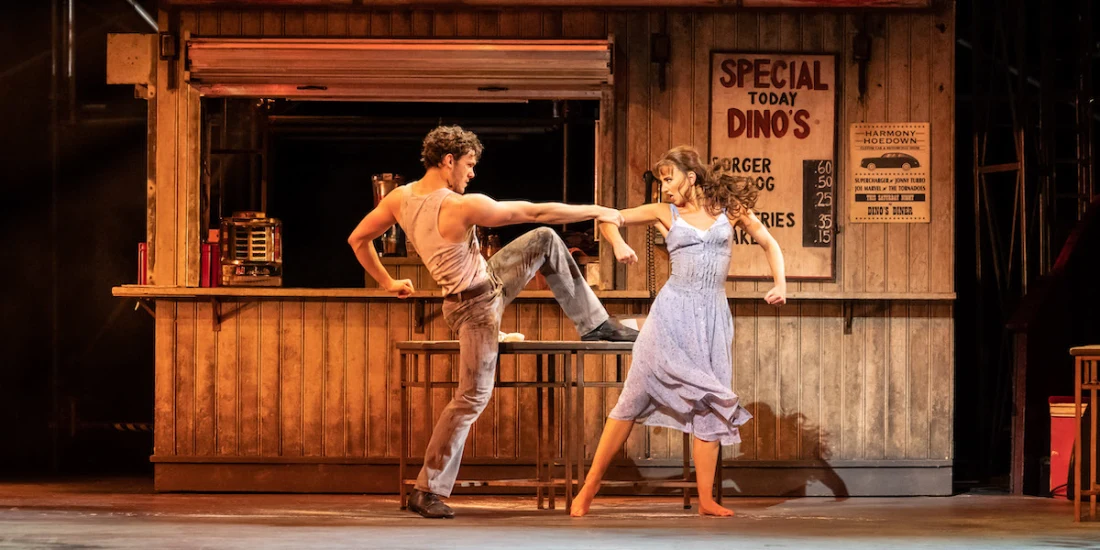'The Car Man' review — Matthew Bourne's steamy dance drama is back with a bang
Never mind the summer heatwave – the hottest place in London right now is the Royal Albert Hall. As part of the venue’s 150th anniversary celebrations, Matthew Bourne has retooled his turbo-charged 2000 production The Car Man, which riffs on both the opera Carmen and the film noir classic The Postman Always Rings Twice.
This new version is bigger and bolder than ever, with a massive cast of 39, a full orchestra (giving a magnificent account of Terry Davies’ reworking of the Rodion Shchedrin Carmen Suite), two retro cars, multiple cinematic screens, and a huge catwalk – framed with telegraph poles – that runs from the stage and all the way through the arena seats. It’s on this stretch of empty road that we first glimpse the brooding stranger sauntering into town, the catalyst for the coming explosion.
Ironically, this small 1960s Italian-American town is named Harmony, one of the many witty elements that perfectly leaven this steamy, violent tale, and which further demonstrate just why Bourne is considered our finest dance storyteller. It really doesn’t matter whether or not you know his source material: a packed Albert Hall audience was rapt throughout.
Lana, the bored wife of the local diner and garage owner, Dino, is immediately drawn to the stranger, Luca. When the pair are finally alone, the atmosphere becomes dangerously charged and we all hold a long breath until they crash into one another in an eruption of forbidden passion. There’s nothing coy or cute about the sex scenes here: this is a sweaty tangle of lustful limbs, brutal grabs and thrusts, and a savagery that hints at the bloodshed to follow.
That carnality is echoed by the company, the muscled, macho mechanics dancing with clenched fists, stamping feet and cigarettes hanging out of their mouths, while the women hoist their skirts and slap the floor. There’s also one gay male coupling, and an amusing subsequent sequence where the male and female lovers of the same man bask in the afterglow, unaware of each other.
But otherwise Bourne stays fairly faithful to his period setting, interrogating a culture of toxic masculinity that sees Lana humiliated and objectified by her boorish husband, and, in turn, use her sexuality to engineer an escape route. We also see the sweet, innocent romance between Lana’s sister Rita and sensitive young Angelo mocked by the others. Luca teaches Angelo to fight, but that only becomes part of his tragic transformation into yet another thuggish man.
Bourne’s characterisation is crystal clear throughout, which helps enormously given that the performances now have to be projected so much further. There’s an assist from Lez Brotherston’s arresting design (that diner is palpably greasy and grimy) and Duncan McLean’s stylish projections, which switch between vintage ads, location shots and old Hollywood-style portraits of our main players at crucial points. But mainly we get all the information we need from the brilliantly tailored movement.
Zizi Strallen immediately locates Lana in her self-consciously slinky walk; she’s always aware of the effect she has on others. Yet there’s a gloomy lethargy to her until Luca arrives, and she suddenly finds a new verve and purpose. Strallen is strongest in these vivacious moments, but I didn’t entirely buy her as the ruthless femme fatale who would dismissively kick a corpse.
Still, she has great chemistry with the sinewy Will Bozier as Luca, and he certainly gives this seducer the full hip-swivelling swagger – plus an unpredictable temper. He’s excellent, too, in the darker second half as his crimes come back to haunt him, particularly in a nightmarish psychological number which sees him partnering a dead body.
Paris Fitzpatrick and Kayla Collymore are also fantastic as the corrupted young couple, dancing with lyrical, heart-wrenching expressiveness throughout, while Alan Vincent’s Dino is an effectively towering monster. And I loved the mini send-up of French mime artists, led by the vivid Bryony Harrison.
Bourne’s production is full of such inventive touches and clever tonal switches, leaping from a whooping hoedown to jailhouse despair and a mighty melodramatic climax. The heat almost becomes an extra character, thanks to Chris Davey’s evocative lighting – a woozy haze with harsh neon from the diner sign or the eerie glow of car headlights – and Paul Groothuis’s cicada and castenet-punctuated soundscape.
The Car Man is also by far the sexiest thing I’ve seen at the Albert Hall, and not just because Bourne includes a naked shower scene with plenty of buff bottoms. Yes, you do miss some of the intimacy in this bigger arena, and the larger chorus doesn’t always feel necessary. But the story’s core desire, desperation and destruction still come across with thrilling force. This unmissable dance drama is a hell of a ride.
The Car Man is at the Royal Albert Hall to 19 June. Book The Car Man tickets on London Theatre.
Photo credit: Will Bozier and Zizi Strallen in The Car Man (Photo by Johan Persson)
Originally published on
